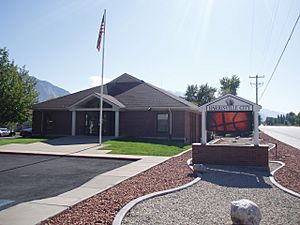Harrisville, Utah facts for kids
Quick facts for kids
Harrisville, Utah
|
|
|---|---|

Harrisville City Hall, October 2011
|
|

Location within Weber County and the State of Utah
|
|
| Country | United States |
| State | Utah |
| County | Weber |
| Settled | 1850 |
| Founded by | Urban Stewart |
| Named for | Martin H. Harris |
| Area | |
| • Total | 2.98 sq mi (7.73 km2) |
| • Land | 2.98 sq mi (7.73 km2) |
| • Water | 0.00 sq mi (0.00 km2) |
| Elevation | 4,308 ft (1,313 m) |
| Population
(2010)
|
|
| • Total | 5,567 |
| • Estimate
(2019)
|
6,872 |
| • Density | 2,302.95/sq mi (889.06/km2) |
| Time zone | UTC-7 (Mountain (MST)) |
| • Summer (DST) | UTC-6 (MDT) |
| ZIP code |
84404
|
| Area code(s) | 385, 801 |
| FIPS code | 49-33540 |
| GNIS feature ID | 2410709 |
Harrisville is a city located in Weber County, Utah, in the United States. In 2010, about 5,567 people lived there. It is part of the larger Ogden–Clearfield metropolitan area. This means it's part of a bigger group of cities and towns that are connected.
Contents
Harrisville's Story
The first people to settle permanently in Harrisville arrived in 1850. A post office was opened in Harrisville in 1871. It stayed open until 1902. The community was named after Martin Henderson Harris, who was one of the first settlers in the area.
Where is Harrisville?
Harrisville covers a total area of about 2.7 square miles (7.0 square kilometers). All of this area is land. There are no large lakes or rivers within the city limits.
Who Lives in Harrisville?
| Historical population | |||
|---|---|---|---|
| Census | Pop. | %± | |
| 1880 | 582 | — | |
| 1890 | 715 | 22.9% | |
| 1900 | 319 | −55.4% | |
| 1910 | 396 | 24.1% | |
| 1920 | 488 | 23.2% | |
| 1930 | 509 | 4.3% | |
| 1940 | 572 | 12.4% | |
| 1950 | 761 | 33.0% | |
| 1970 | 749 | — | |
| 1980 | 1,371 | 83.0% | |
| 1990 | 3,004 | 119.1% | |
| 2000 | 3,645 | 21.3% | |
| 2010 | 5,567 | 52.7% | |
| 2020 | 7,060 | 26.8% | |
| 2023 (est.) | 6,802 | 22.2% | |
| U.S. Decennial Census | |||
In 2000, there were 3,645 people living in Harrisville. Many of the households were families. About 58.5% of homes had children under 18 living there. Most of the households, about 77.5%, were married couples living together.
The population in Harrisville is quite young. About 39.3% of the people were under 18 years old. The average age of people in the city was 26 years. This shows that many young families and children live in Harrisville.
How Harrisville is Represented
Harrisville is part of Utah's 1st congressional district. This district is an area that elects one person to represent them in the United States Congress. For the 118th United States Congress, Harrisville is represented by Blake Moore. He is a member of the Republican Party.
See also
 In Spanish: Harrisville (Utah) para niños
In Spanish: Harrisville (Utah) para niños

